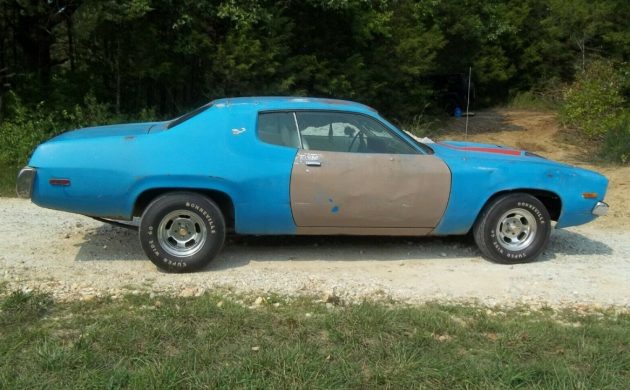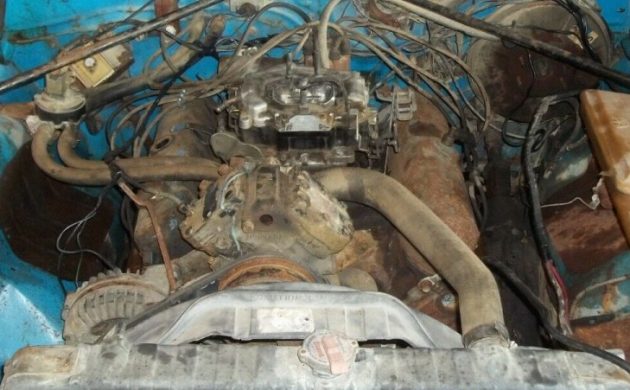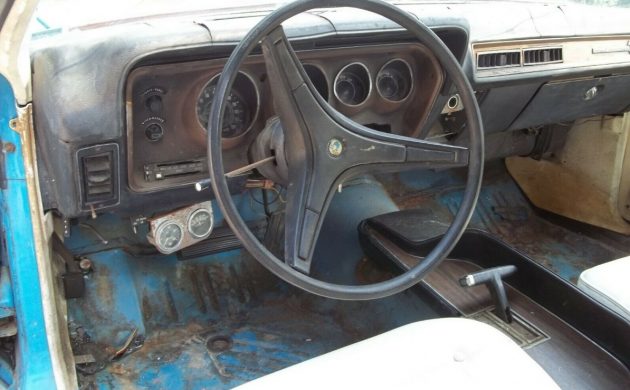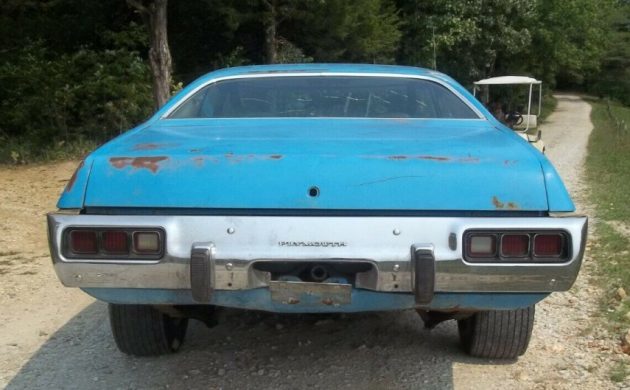Most things eventually come into their own. The first-gen (’68-’70) Plymouth Road Runner has been a hot collectible ticket for a long time and the second-gen (’71-’74) is following suit – maybe not quite to the extent yet, but they are on the move. So, with that thought, let’s examine a 1973 Road Runner that is located in St. Louis, Missouri, and is available, here on eBay for a current bid of $9,150 with 31 bids tendered so far.
The year 1973 was an interesting one for all things automotive. All-in-all, it was a strong sales year though the October oil embargo kicked a wrench into the works – mostly felt in the ’74 model year. The Fed’s action on clean air and safety influenced an auto landscape, greatly now changed from just three short years earlier. The muscle car, an American automotive staple, at least since 1964, if not earlier, was clearly on the way out and manufacturers bobbed and weaved to salvage the dying trend as best they could. And a standby of that era, the Plymouth Road Runner, made adjustments to conform to the changing times.
Redesigned in ’71, Mopar’s B-Body was known as a fuselage design. I’m probably in the minority but I like the ’73-’74’s front-end facelift more than the original ’71-’72 version. I particularly appreciate the way that Plymouth tucked in the mandated five MPH bumpers; some of GM and Ford’s ’73 entries are abominable. Our subject car, painted in “Petty” blue supposedly was held in an indoor collection over the last three years. Prior to that, it was in California and is believed to have been off the road since ’85. Nevertheless, it looks like a lot of found Road Runners do, worn and banged up so it’s seen a lot of outside time. The seller states, “It needs no rot/rust repair, any rust you see is surface rust. All trunk floors and interior floors, frame rails, trunk drops are amazing. The quarters, fenders, trunk, hood driver’s door are all rust-free and dented (a good PDR guy should be able to remove), pass door has Bondo in it, likely not rust but dents“. OK, so maybe we’re just talking aesthetics and the typically found rot quotient is low. The underside, which is well represented pictorially, looks fine, just some expected scale and surface rust but it’s really quite clean – must have been its California upbringing. Note the wheels and jacked-up rear, they are a fitting tribute to the ’70s.
Things in the clean air department started to get serious in ’73 and as the trend towards high-powered asphalt peelers diminished, Plymouth took advantage of that direction and made do with a 170 net HP, 318 CI V8 engine as standard RR fare. The only performance aspect to it was its dual exhaust system. But options abounded and the original orderer of this Petty-inspired Plymouth selected a 240 net HP 340 CI V8, a powerplant that still performed respectfully, if not quite with the same determination as to its ’68-’71 ancestors. The engine is claimed to be the original matching number motor that “doesn’t run but it is not stuck“. The commonly found TorqueFlite A-727 three-speed automatic transmission sends power to those oversized rear wheels. Big block engines, a Road Runner go-to for years, were still available in this model including a 280 net HP 440 CI V8 that was available only with the seldomly encountered “GTX” option. The RR’s original mule team, the “Road Runner 383” was replaced in ’72 with the similar, but less powerful 400 CI “B” block V8.
So, how’s the white interior holding up? Well, the seats look pretty good but the rest could use some assistance. The carpet is up, but you get to see the condition of the floors and they check out other than the surface rust. The dash pad is kaput, the instrument panel has seen better days and the headliner is missing. The console, however, looks useable as do the rear upholstery panels – no view available of the door panels, however. Auxiliary gauges were added somewhere in this Plymouth’s past but they are unceremoniously hanging on, barely, to the underside of the dash.
OK, no reserve here so this bird is going to find a new home. In spite of it being a little rough around the edges, but a lot better than some Road Runners featured here, it appears to be a pretty intact, second-gen car with nice originality and possibility. There are four days to go with the auction and if the price trends reasonably, someone’s going to get a good project basis for an up-and-comer, wouldn’t you agree?








Sure wish there was a “Look at it now” page so that we could see how some of these projects turned out!
I agree, Jim. ’73-74 did look better.
I’ve always like this body style , but always ended up with A body Mopars … By the way, the color is not Petty blue , its Basin St. Blue, or True Blue in the Dodge world .
While it was known as Basin Street Blue and True Blue in Plymouth and Dodge showrooms, in reality it was Chrysler’s Corporate Blue, and Plymouth’s divisional color, as well.
That was the reason that its code was TB3, not HB3. New colors added to the corporate palate in 1972 would normally have been assigned a color code beginning with “H”, and the codes for all of the other “new for ’72” colors did begin with “H”, except for this one. Chrysler had a few “permanent” colors in their palate, and those always began with “T”, including black (TX9), Corporate Blue (TB3), and whatever the code was for Dodge’s divisional red.
I had a 72 Duster in the same color ; I liked it so much that when I started hobby stock racing, my cars were always painted this color . This car looks to have been around the short track circuit- its rust free, but dented all over !
“Oversized tires” , sorry not included .
I actually liked the 71/72 front and rear ends better I’d also like a real 440 thanks
Rare red stripe car……..an interesting color combo for this…seen a restored version once….this was a design I liked and way better looking than 75-80 offerings